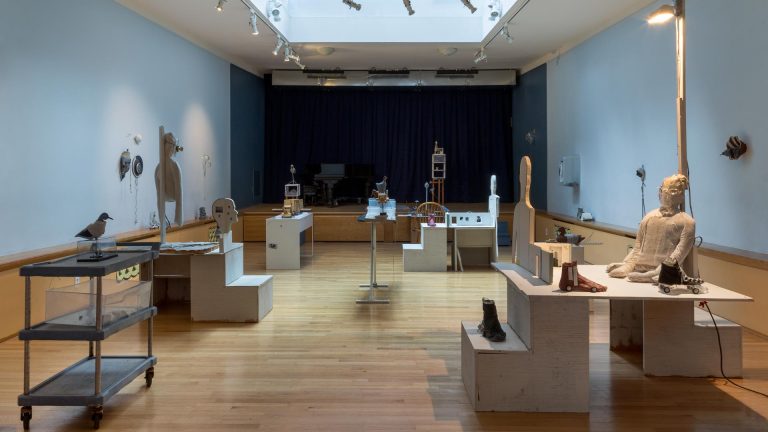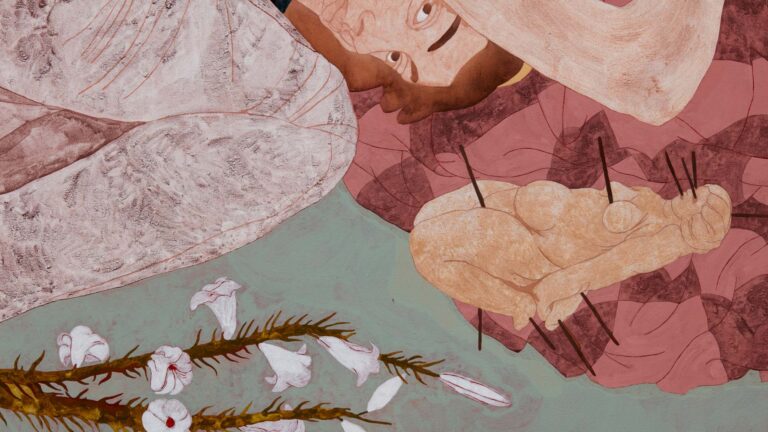Artist: Sissel Blystad
Exhibition title: Glenne
Venue: HESTER, New York, US
Date: October 14 – November 13, 2016
Photography: all images copyright and courtesy of the artist and HESTER
HESTER is pleased to present Glenne, the gallery’s first solo exhibition of works by Sissel Blystad (b. 1944, Oslo; lives and works in Bergen, Norway). A central figure within Scandinavian textile arts for more than four decades, Blystad is recognized for her sustained extension of the formal terms, compositional procedures, and material determinations associated with the woven image. Focusing on recent large-scale tapestries and shaped textiles, this exhibition marks the initial presentation of her work to U.S. audiences.
Blystad’s expansive tripartite tapestry, Landskap, completed in 2005, is arguably the most visible artwork in Norway. Installed in the National Parliament’s press room, the expansive textile emblematizes the nation’s natural features and serves as the backdrop for televised political speaking engagements. This public rendering of landscape through textile arts traces to the country’s romantic nationalist movement, a mid-19th century cultural declaration of Norwegian national identity. Extending beyond these protocols, the bodies of work featured in Glenne introduce recent developments in the artist’s practice while adjourning from the context of public display in which her work has been most operative to date.
Prior to the growth of Norwegian feminist movements and related assertions of artistic independence by artists such as Synnøve Anker Aurdal, Hannah Ryggen, and Frida Hansen, Norwegian public tapestries were designed by men but woven by women, decorating spaces and existing as images of a masculinist culture. Such tapestries are massive yet contained as rectangles, with uniformity in their motifs. By contrast, Blystad’s work consistently experiments with pattern, and her newest compositions withdraw radically from the restrictions set upon a textile’s form – their profiles evoking ambiguity, play, and the improvisatory activities of an artist’s hand freed of the loom’s logics to explore extemporaneous contours both analogous to drawing and engaging sculptural variables.
Continuous experimentation over the course of more than forty years has led Blystad’s work to individualized, often innovative, decisions about structure, materials, color, and scale. Her early work evolved within the context of the Bergen Arts development initiated by “Group 66,” whose activities culminated while she was a student, and The Finnegård circle, the Lyn Group, Gallery l, the West Norway Art Academy, and the Artists’ Centre supply a wider historical berth for the city’s concentration of textile production. Following her degrees from the Norwegian National Academy of Craft and Art Industry, Oslo, in 1965, and Bergens Kunsthåndverksskole, Bergen, in 1970, Blystad established a textile workshop with the artists Sissel Calmeyer, Anne Sæland, and Sissel Ree Schjønsby in Bryggen, where with the use of a large flat loom she developed minimalist, multistriped blankets from Finnish flax, gaining her practice a reputation for extraordinary nuance in its chromatic transitions and recognizable compositional rigor.
Beginning in 1985, while working from home, Blystad would take further steps to gain complete control of color choices and quality of line, electing to hand-dye a wool yarn made by Hoelfeldt-Lund in Grimstad with which she has worked ever since. Unusually thick for textile work, it is a rough, rugged fiber intended for carpeting, and its use has augmented her work’s archival fixity and robust linear outlines. Refusing to turn from the domestic connotations of the medium, the formal properties of this decision further ensure the even application of color to each thread, albeit introducing difficulties in dyeing, as well as a specific luster modulated by the pronounced waver in the bulge of broader fibers.
In 1992, she was among the first artists to incorporate digital drawing to guide compositional decisions in textiles. Recognizing parallels between a virtual toolset and the pixelated grain of her fibers, she would implement an early Amiga computer and printer to reflect the specific vernaculars of emergent digital effects and changing conditions of viewing before translating these outcomes to weaving. In 2010, Blystad was struck by an automobile while bicycling; breaking both arms in the accident, she accumulated even greater formal dexterity and further elasticity in her approach to her medium when recognizing that she could no longer weave heavy textiles.
Removing the floor loom from her working methods, thick Norwegian fibers are inserted now by hand, arranged variably in arcing lines and complementary geometrics within the space of frequently shaped supports. Through these resourceful processes of excision and recombination of interference patterning – Blystad’s works have amplified their three-dimensional depth, with unfastened tessellations appearing to lift off two-dimensional surfaces with kaleidoscopic rhythmic pacing. Questions of the temporal length of these gestures – from the long durations of hand-dying to the immediate decisions of cutting and collage – enter as a further complication, the application of time being a non-negotiable parameter in the production of textile art.
Apertures, undulating cells, and softened geometries replace the rigid squares and rectangles that typically constitute tapestries, rugs, and blankets. Her shaped works tend towards firmer concentration in size, but this is not to say that these compositions reinforce gendered notions of scale and form with regard to fine arts and crafts. They instead reflect a desire to reference and contend with not only the aggregate weight of Norway’s textile history but also that of broader formal vocabularies. In their utility, simplicity, rhythm, and the annexation of new design protocols towards the development of a unified visual lexicon, these works also relay the philosophies of Bauhaus craftsmanship. Cumulatively reconciling historical dialogues, they merge explorations of relative chromatic scales with elements shared by Op Art and Norwegian west coast weaving customs. Yet for all their historical grounding, the works’ zones of dynamically interposed shapes and colors renegotiate the terms of Blystad’s antecedents – carrying an impression of intensified landscape, an unfixed and frenetic quality accentuated by enclosing volumes in modes previously unconsidered or impossible.
Sissel Blystad’s solo exhibitions include: Hester, New York; Kunstgarasjen, Bergen; Bømlo Kunstlag, Bømlo; Sandnes Kunstforening, Sandnes; Vestfossen Kunstlaboratorium, Vestfossen; Tidens Krav, Oslo; Fjordbutikken, Vevring; Galleri Parken, Bergen; HV Galleri, Stockholm and Kunstnerforbundet Oslo, among others. Group exhibitions include: Bergen Gamle Fengsel, Bergen; Kunstindustrimuseet Oslo; Visningsrommet USF, Bergen; Laura Bartlett Gallery, London; Kunstmuseum Kube, Sølvberget Kulturhus, Stavanger; West Norway Museum of Decorative Art, Bergen; Nordenfjeldske Kunstindustrimuseum, Trondheim; Konstepidemin, Gothenburg. Her works have gained extensive public commissions and are included in significant collections including: Norwegian Stortinget, Oslo; Vestlandske Kunstindustrimuseum, Bergen; Osterøy Videregående Skole, Lonevåg; Fyllingsdalen Sykehjem/Bergen Kommune, Bergen; Olsvikåsen Videregående Skole, Olsvik; St. Olavs Hospital, Trondheim; Molde Kunstforening, Molde; and Sparebanken Vest, Bergen, among numerous others.
Sissel Blystad, Glenne, 2012
Hand-dyed Norwegian wool, 54 1/2 x 69 in. / 138.4 x 175.2 cm
Sissel Blystad, Glenne, 2012
Hand-dyed Norwegian wool, 54 1/2 x 69 in. / 138.4 x 175.2 cm
Sissel Blystad, 11, 2013
Hand-dyed Norwegian wool, 22 x 28 1/4 in. / 55.9 x 73 cm
Sissel Blystad, 11, 2013 (detail)
Hand-dyed Norwegian wool, 22 x 28 1/4 in. / 55.9 x 73 cm
Sissel Blystad, 21, 2015
Hand-dyed Norwegian wool, 25 3/4 x 26 in. / 65.4 x 66 cm
Sissel Blystad, 21, 2015 (detail)
Hand-dyed Norwegian wool, 25 3/4 x 26 in. / 65.4 x 66 cm
Sissel Blystad, 25, 2016
Hand-dyed Norwegian wool, 21 x 34 in. / 53.3 x 86.3 cm
Sissel Blystad, 25, 2016
Hand-dyed Norwegian wool, 21 x 34 in. / 53.3 x 86.3 cm
Sissel Blystad, 19, 2015
Hand-dyed Norwegian wool, 27 x 23 in. / 68.6 x 58.4 cm
Sissel Blystad, 19, 2015 (detail)
Hand-dyed Norwegian wool, 27 x 23 in. / 68.6 x 58.4 cm
Sissel Blystad, Fest, 2011
Hand-dyed Norwegian wool, 57 x 71 in. / 144.8 x 180.3 cm
Sissel Blystad, Fest, 2011 (detail)
Hand-dyed Norwegian wool, 57 x 71 in. / 144.8 x 180.3 cm
Sissel Blystad, Fest, 2011 (detail)
Hand-dyed Norwegian wool, 57 x 71 in. / 144.8 x 180.3 cm
Sissel Blystad, Pryd, 2011
Hand-dyed Norwegian wool, 52 x 70 in. / 144.8 x 180.3 cm
Sissel Blystad, Pryd, 2011 (detail)
Hand-dyed Norwegian wool, 52 x 70 in. / 144.8 x 180.3 cm
Sissel Blystad, Pryd, 2011 (detail)
Hand-dyed Norwegian wool, 52 x 70 in. / 144.8 x 180.3 cm
Sissel Blystad, 10, 2013
Hand-dyed Norwegian wool, 30 x 17 1/2 in. / 76.2 x 44.5 cm






























